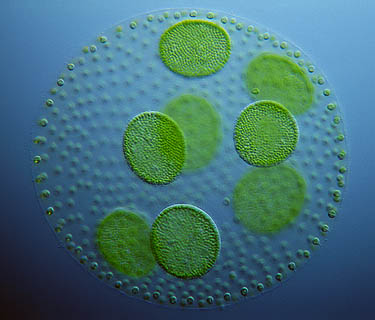Key words :
future energies,
,
biofuel
,carbon emissions
,rape seed
,switch grass
,algae
,algal
,canola
,corn
Report Says, Algal Biofuels May Not Cut Carbon Emissions, but Read it More Closely.
8 Apr, 2010 09:48 am
According to a life-cycle analysis, growing algae to make biofuels is overall worse in terms of carbon-emissions than growing land-based crops like corn, canola (rape-seed) or switch grass. However, if the algae plant is situated near both a power station and a sewage works, so it can clean CO2 from smokestacks and nitrogen and phosphorus nutrients from the wastewaters, growing algae may become more environmentally beneficial than the land-based crops.
 A new study suggests that overall the CO2 emissions attendant to growing algae
for the production of biofuels may be worse than those from corn, canola (rape-seed) or switch grass.
The main problem is the use of carbon dioxide brought from elsewhere in
"gas-bottles" and inputs of fertilizer, particularly nitrogen and
phosphorus. According to a Life-cycle analysis, the land-based crops all
were found to sequester more carbon than that incurred in growing them,
while the contrary was true for growing algae, meaning that replacing
fossil fuels by algal fuels could cause an overall increase in carbon
emissions.
A new study suggests that overall the CO2 emissions attendant to growing algae
for the production of biofuels may be worse than those from corn, canola (rape-seed) or switch grass.
The main problem is the use of carbon dioxide brought from elsewhere in
"gas-bottles" and inputs of fertilizer, particularly nitrogen and
phosphorus. According to a Life-cycle analysis, the land-based crops all
were found to sequester more carbon than that incurred in growing them,
while the contrary was true for growing algae, meaning that replacing
fossil fuels by algal fuels could cause an overall increase in carbon
emissions.Not surprisingly, the report just published in the prestigious American Chemical Society journal, Environmental Science and Technology, has put the cat among the pigeons, since there are many companies gearing-up to produce algal biofuels. The US Algal Biomass Organisation has claimed that the study contained "faulty assumptions" and was based on "grossly outdated data".
Now, I am a fan of growing algae not the least of which because to do so means that far more fuel might be produced per unit area than is the case from the above mentioned land-based crops, as algae have a better photosynthetic yield; there is no need to use freshwater since algae grow well (even better) on saline waters or wastewaters, thus preserving an already endangered resource; you can put the tanks on any land (even deserts), so there is no need to compromise food-production in a competition over the same arable land to grow food-crops or fuel-crops; they might be used to clean CO2 from the smokestacks of power-stations fired from e.g. gas or coal; they might be used to clean wastewaters of nitrogen and phosphorus.
On closer inspection, the report is in fact very positive about growing algae, particularly in the latter two respects. Read positively, the data are only in opposition to making fuel from algae if nitrogen and phosphorus nutrients are added in their mineral forms, and if the CO2 has to be injected into the system (transported as a compressed gas) as made mainly by the process of steam reforming methane, along with most of the world's available hydrogen:
(Overall) CH4 + 2 H2O --> CO2 + 4 H2.
That H2 is used to make nitrogen (ammonium sulphate and nitrate) fertilizer by reacting it with N2 via the Haber Bosch process to make ammonia (NH3), and so there is in a way a symbiosis between the production of CO2 and NH3. The phosphorus would likely come from mining "rock phosphate", which requires energy too.
However, the figures in this "cradle to farm gate" analysis (i.e. they do not include the energy costs of processing the algae or other biomass into fuel per se) show that if the production of algae is combined with a wastewater treatment strategy, so that N and P are removed from it by the algae (an otherwise energy intensive procedure), and fed with CO2 from smokestacks (thus reducing the carbon emissions from a power plant), most of the environmental burdens attendant to growing algae are offset. Thus, an algae production plant, a power station and a sewage-works should all be built in mutual proximity. Of three possible municipal wastewater effluents evaluated as a source of N and P, the most effective was source-separated urine with a very high content of these elements, in which case growing algae became more environmentally beneficial than the land-based crops.
Even should some dispute over the exact figures used remain, what the study does highlight is the importance of developing an integrated paradigm of production and recycling for algal fuel production as I have stressed before is vital, in the context of rare metals such as are required to maintain the electronics and solar power industries.
Related Reading.
"Environmental Life Cycle Comparison of Algae to Other Bioenergy Feedstocks," By Andres F. Clarens, Eleazer P. Ressurreccion, Mark A. White and Lisa M. Colosi, Environ. Sci. Technol., 2010, 44, 1813.
Key words :
future energies,
,
biofuel
,carbon emissions
,rape seed
,switch grass
,algae
,algal
,canola
,corn
-
12/12/12
ÂPeak Oil is Nonsense Because ThereÂs Enough Gas to Last 250 Years.
-
05/09/12
Threat of Population Surge to "10 Billion" Espoused in London Theatre.
-
05/09/12
Current Commentary: Energy from Nuclear Fusion  Realities, Prospects and Fantasies?
-
04/05/12
The Oil Industry's Deceitful Promise of American Energy Independence
-
14/02/12
Shaky Foundations for Offshore Wind Farms







 Read more
Read more
No matter what clever $cheme humans might cook up to attenuate carbon emissions, there is ONLY one that will truly work. And even this might not work. It may be to late.
If ewe folks really want to mitigate carbon emissions on Planet Earth, a closed looped system that sustains the only known sentient life, then humanity will have to abandon the DOCTRINE OF PERPETUAL GROWTH... especiually in regard to the human population and the global consumer economy.
Again... it matters not what ewe folks do! All will fail if the issue of overpopulation is not seriously addressed. I don't care what the Pope says. Overpopulation IS the bottom line! It IS the biggest elephant in the livingroom. Humans have less than 10 earth years to fix it. After that... comes an major extinction event.
I have quoted previously a Hubbert type analysis as applied to human population growth rather than the production of oil. However, the two are closely connected for the present population of 6.8 billion would not have arisen had it not been "fed" by cheap and plentiful oil.
It is clear that the oil-age is not going to continue for much longer. The chilling conclusion of the analysis is that rather than a world population rising above 9 billion by 2050 as the WHO has reckoned, it will instead reach a maximum of 7.1 billion in 2024 and then decline to perhaps 2.5 billion by the end of the century, 2100.
This is surely the die-off scenario you allude to which will be driven almost certainly by a lack of resources to provide otherwise
Thanks for your integrative thinking about how to make algal fuels workable. Society has been woefully lacking in this type of thinking to date. For example, we lose two-thirds of the energy produced by fossil-fuel fired power plants in the form of waste heat which is rarely captured and used for other purposes. We did this because we thought it more efficient to build huge centralized power production facilities far from population centers during an era of seemingly endless fossil fuel supplies. This has made it difficult, if not impossible, to recapture that wasted energy since the buildings and factories which might use it are not nearby. Let us not make the same types of mistakes with algal biofuels.
thanks! This is surely the only way forward, to integrate formally different actions in an holistic way. The aspect of recycling needs to be designed-into the whole, ab initio, including the recovery and use of metals, and indeed the recovery of as much of the heat from power stations. Of course this applies to nuclear power stations, too, which waste the same amount as fossil-fuelled power plants. CHP on the more decentralized (local) level must play an increasingly important role too, in the absence of extensive cheap transportation, and algae might be efficiently produced to provide liquid fuels for small communities, but as part of an integrated strategy.